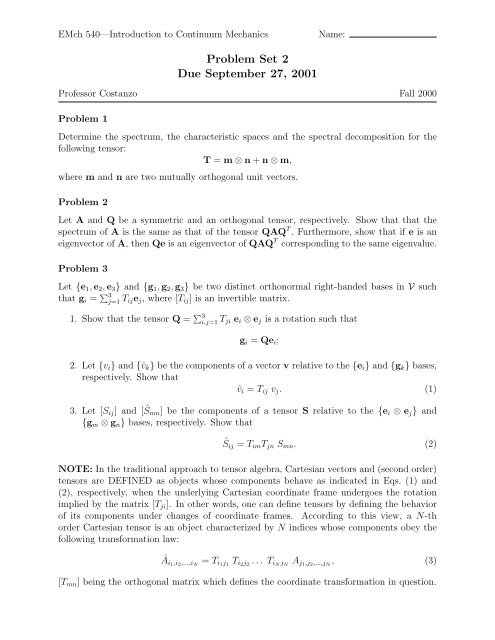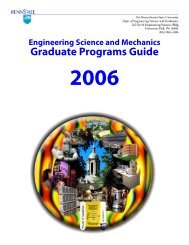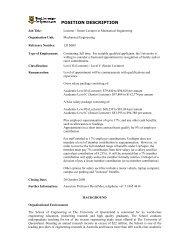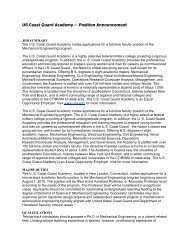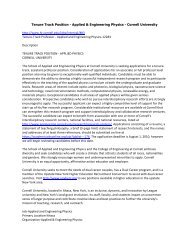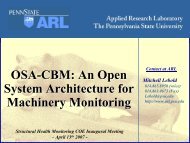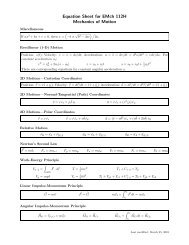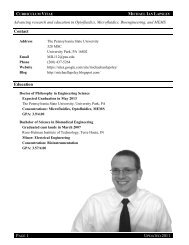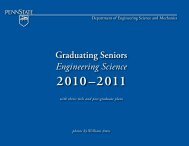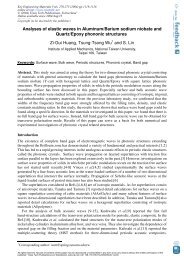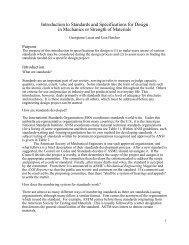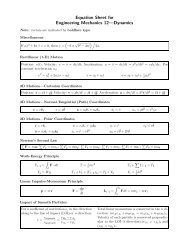Problem Set 2 Due September 27, 2001
Problem Set 2 Due September 27, 2001
Problem Set 2 Due September 27, 2001
You also want an ePaper? Increase the reach of your titles
YUMPU automatically turns print PDFs into web optimized ePapers that Google loves.
EMch 540—Introduction to Continuum Mechanics Name:<br />
<strong>Problem</strong> <strong>Set</strong> 2<br />
<strong>Due</strong> <strong>September</strong> <strong>27</strong>, <strong>2001</strong><br />
Professor Costanzo Fall 2000<br />
<strong>Problem</strong> 1<br />
Determine the spectrum, the characteristic spaces and the spectral decomposition for the<br />
following tensor:<br />
T = m ⊗ n + n ⊗ m,<br />
where m and n are two mutually orthogonal unit vectors.<br />
<strong>Problem</strong> 2<br />
Let A and Q be a symmetric and an orthogonal tensor, respectively. Show that that the<br />
spectrum of A is the same as that of the tensor QAQ T . Furthermore, show that if e is an<br />
eigenvector of A, then Qe is an eigenvector of QAQ T corresponding to the same eigenvalue.<br />
<strong>Problem</strong> 3<br />
Let {e1, e2, e3} and {g1, g2, g3} be two distinct orthonormal right-handed bases in V such<br />
that gi = 3 j=1 Tijej, where [Tij] is an invertible matrix.<br />
1. Show that the tensor Q = 3 i,j=1 Tji ei ⊗ ej is a rotation such that<br />
gi = Qei;<br />
2. Let {vi} and {ˆvk} be the components of a vector v relative to the {ei} and {gk} bases,<br />
respectively. Show that<br />
ˆvi = Tij vj. (1)<br />
3. Let [Sij] and [ ˆ Smn] be the components of a tensor S relative to the {ei ⊗ ej} and<br />
{gm ⊗ gn} bases, respectively. Show that<br />
ˆSij = TimTjn Smn. (2)<br />
NOTE: In the traditional approach to tensor algebra, Cartesian vectors and (second order)<br />
tensors are DEFINED as objects whose components behave as indicated in Eqs. (1) and<br />
(2), respectively, when the underlying Cartesian coordinate frame undergoes the rotation<br />
implied by the matrix [Tji]. In other words, one can define tensors by defining the behavior<br />
of its components under changes of coordinate frames. According to this view, a N-th<br />
order Cartesian tensor is an object characterized by N indices whose components obey the<br />
following transformation law:<br />
Âi1,i2,...,iN = Ti1j1 Ti2j2 . . . TiN jN<br />
Aj1,j2,...,jN , (3)<br />
[Tmn] being the orthogonal matrix which defines the coordinate transformation in question.
EMch 540—Introduction to Continuum Mechanics Name:<br />
<strong>Problem</strong> 4<br />
Let F = RU = VR denote the right and left polar decompositions of F ∈ Lin + , where Lin +<br />
is the collection of all tensors with positive determinant.<br />
1. Show that U and V have the same spectrum (ω1, ω2, ω3).<br />
2. Identify the relationship between the eigenvectors ei of U and the eigenvectors fi of V<br />
corresponding to the eigenvalue ωi.<br />
3. Prove that F and R admit the following representations:<br />
3<br />
F = ωifi ⊗ ei,<br />
3<br />
R = fi ⊗ ei,<br />
i=1<br />
i=1<br />
where ei and fi are, respectively, the eigenvectors of U and V corresponding to the<br />
eigenvalue ωi.<br />
Hint: start by recalling that the identity tensor can be represented using the vectors fi<br />
or ei, that is, for example, I = 3 i=1 fi ⊗ fi. Then, combine this result with a relation<br />
ship that expresses fi in terms of ei.


